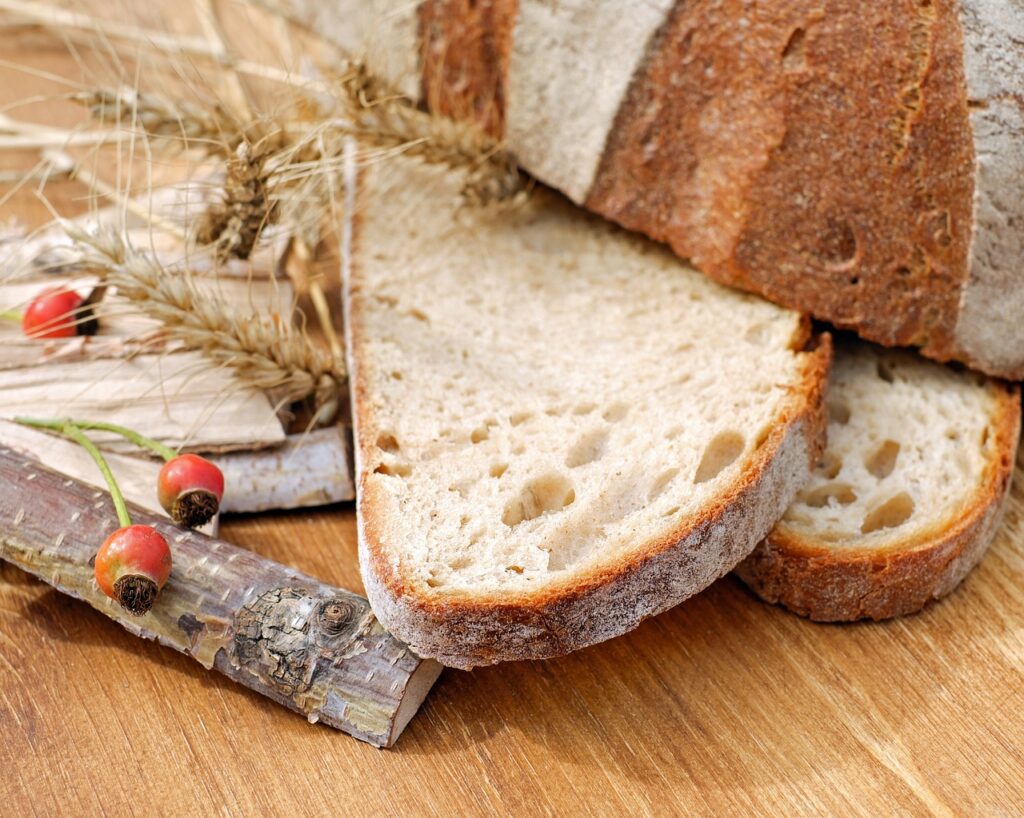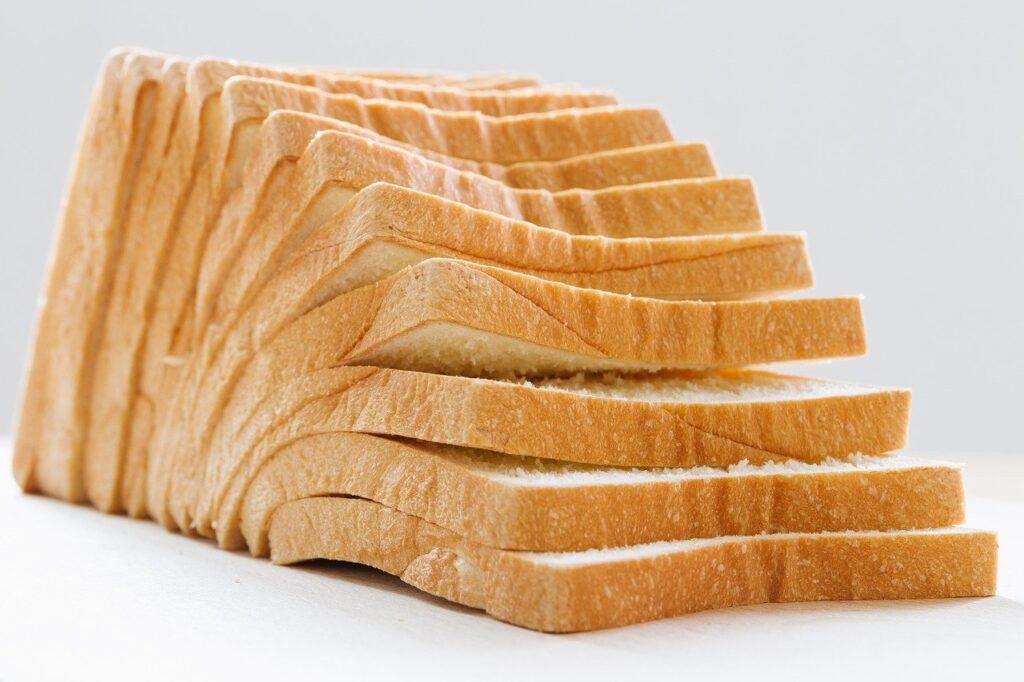Introduction
Bread is a staple food prepared by baking dough made from flour and water. Infinite combinations of different flours, and differing proportions of ingredients, have resulted in a large variety of types, shapes, sizes, and textures of bread. It may be leavened using naturally occurring microbes or may be unleavened. There are three general types of bread: leavened, flat and steamed bread. Each bread type differs from one another on specific end-product properties, processing conditions and grain quality needs. Bread staling is a common problem in the bread industry.
Food safety knowledge is for all!

Every consumer deserves to have high quality and safe food. …Read more!

What is Bread Staling
Bread staling is a complex process that involves loss of aroma, loss of crumb softness, changes in mouth feel and increase in bread crumbliness. It is usually characterized by toughening of the crust, firming of the crumb, loss of moisture and flavor, and a corresponding loss in product freshness (Hoseney, 1994).
It is a term which indicates decreasing consumer acceptance of bakery products caused by changes in crumb other than those resulting from the action of spoilage microorganisms. (Bechtel, Meisner and Bradley, 1953) It is thought to be a complex phenomenon that originates from multiple physico-chemical events including amylopectin retrogradation, water loss and redistribution that are not yet completely verified (Curti, et al, 2011).

Staling of baked products results in considerable losses to the bakeries, supermarkets and consumers who prefer fresh products. (Graybosch, 1998). Although it has been studied for a very long time, bread staling has not been eliminated and it therefore remains responsible for huge economic losses to both the baking industry and the consumer (Gray & Bemiller, 2003a)
Theories used to explain bread staling phenomenon
The staling of bread has been widely discussed from various points of view. It is believed that polymer crystallizations with the formation of super molecular structures are involved in the bread staling process. (Gray & Bemiller, 2003b) Structurally, bread staling is thought to originate from starch retrogradation, modification in the gluten structure and a partial re-distribution of moisture from the gluten to the starch fraction of the crumb (Willhoft, 1973).
Gray & Bemiller, 2003a belief that the most possible conclusion is that retrogradation of amylopectin in bread occurs, and thus water molecules are incorporated into the crystallites, therefore, distribution of water is shifted from gluten to starch, thereby changing the nature of the gluten network and thus bread stales. This has been supported by (Choi, Kim, & Baik, 2010) who identified the main causes of bread staling to be water migration and redistribution, starch retrogradation and gluten transformations.
Water migration and redistribution during bread staling
The migration of water from crumb to the crust is attributed to be a major cause of bread staling. This is because the migration of water in cellular solid foods during storage has been found to cause loss of crispness. (Voogt, Hirte, & Meinders, 2011) It was proven by Piazza & Masi, 1995, that to prevent the staling process, it is more important to slow down the dehydration phenomena rather than it is to increase the initial moisture content in the bread indicating that loss of moisture contributes to the staling phenomenon.
While studying water texture firming, amylopectin recrystallization, and water relations in standard white breads and Meal, ready to eat breads, (Hallberg And Chinachoti 2002) had found out that prevention of moisture loss using hematic pouches inhibited bread firming. Firming occurred faster due to the loss of moisture to the crust and the surrounding environment when the bread was stored without any covering.
The presence of the crust and its effect on moisture redistribution has also been found key in enhancing bread staling. When bread is stored with the crust intact, water has been found to migrate from the crumb to the crust and hence the crumb firms. This is accompanied by a decrease in freezable water and water activity. When the bread is stored without the crust, insignificant moisture changes in the crumb have been registered.
Water activity changes are also minimal (Baik & Chinachoti, 2000). This indicates that water has a major role to play in bread firming process since all breads are sold with the crust intact. This was confirmed by (Aguirre, Osella, Carrara, Sánchez, & Buera, 2011) and (Bosmans, Lagrain, Ooms, Fierens, & Delcour, 2013) who found out that when bread was stored with crust, the crust trapped moisture from the crumb, resulting in a dehydration of the crumb what accelerated the rate of staling.
Besides firming, water migration increases un-freezable water fraction of bread. It has been shown that the loss in freezable water occurs due to incorporation of water into the starch crystalline structure and water migration from the crumb to the crust. (Ribotta & Le Bail, 2007) This loss in freezable water means that the water that remains in the crumb is bound and therefore not available for softening or moisturizing the bread particle and thus bread is firm.
Moisture has also been found to affect starch retrogradation which is a major cause of bread staling. It has been found to determine the extent to which starch retrogrades. (Zeleznak & Hoseney, 1996). Gray and Bemiller 2003a in their bread studies concluded that retrogradation of amylopectin occurs during bread staling, involving incorporation of water molecules into the crystallites, and thus the distribution of water is shifted from gluten to starch, thereby changing the nature of the gluten network and hence firming occurs.

Amylopectin recrystallization has been found to strengthen the starch network with concomitant inclusion of water and increased crumb firmness. The inclusion of water and the thermodynamic immiscibility of starch and gluten results in local gluten dehydration during bread storage. Moisture migration from crumb to crust further reduced the level of plasticizing water of the biopolymer networks and contributed to crumb firmness at longer storage times which eventually produces stale bread. (Bosmans et al., 2013).
This confirms what (Gray & Bemiller, 2003a) had earlier found. In a research involving arabinoxylan preparations (Biliaderis, Izydorczyk, and Rattan, 1995) found out that high levels of moisture in bread as a result of use of the arabinoxylan preparations increased the retrogradation of starch despite the fact that they were slightly softer than their controls. This was because breads containing High Molecular Weight arabinoxylans retained a relatively higher amounts of moisture. However, retrogradation was reported to increase extensively because of the high moisture levels in the baked bread.
This indicates that despite the fact that water moistens and softens bread, it also enhances starch retrogradation which is vital in enhancing staling. This is in agreement with (Piazza & Masi, 1995) who found out that it was better to prevent bread staling by preventing moisture loss from the bread than increasing the moisture content of bread.
This information leaves the actual role of water in bread staling unclear. The optimum amount of moisture at which bread staling is minimum and softness maximum is left undefined.
Starch retrogradation in bread staling
Retrogradation is a reaction that takes place in gelatinized starch when the amylose and amylopectin chains realign themselves, causing the liquid to gel. Starch therefore tries to attain the original crystalline structure it had before. Starch molecules bond more closely overtime increasing structure as the starch paste cools (Figoni, 2008).
When native starch is heated and dissolves in water, the crystalline structure of amylose and amylopectin molecules is lost and they hydrate to form a viscous solution. If the viscous solution is cooled or left at lower temperature for long enough period, the linear molecules of amylose, amylopectin molecules retrograde and rearrange themselves again to a more crystalline structure. The linear chains place themselves parallel and form hydrogen bridges.
Food safety knowledge is for all!

Every consumer deserves to have high quality and safe food. …Read more!

The moisture content of a starch gel determines the extent to which that starch will retrograde. Maximum crystallinity occurs in gels of 50-60% starch. (Zeleznak & Hoseney, 1996). When staling is measured as hardness increase and amylopectin retrogradation, it is found to increase along the frozen storage of bread. (Barcenas and Rosell 2006).
The development of bread firmness during storage has been found to be correlated to amylopectin retrogradation and to changes in the freezable water fraction of the breads in a non-linear manner, suggesting that bread firmness is influenced by both the crystallisation behavior of starch and by changes in hydration. (Rasmussen & Hansen, 2001).
Experiments involving study of bread firming during storage time have also revealed that starch crystallinity, amylopectin retrogradation and bread firming are correlated. Both crumb-firming and amylopectin retrogradation increase with storage time. This confirms earlier studies that amylopectin retrogradation is an important component in bread staling. (Ribotta, Cuffini, León, & Añón, 2004)
When starch retrogradation process is inhibited, less bread staling is observed. Prevention of starch retrogradation using substances that hinder retrogradation of starch has been shown to reduce bread staling indicating a viable link between starch crystalization and firming of bread. The presence of hydroxypropylmethylcellulose was found to reduce the hardening rate of the bread crumb by retarding the amylopectin retrogradation. (Bárcenas & Rosell, 2005)
The condition of the flour is also crucial as far as retrogradation of starch is concerned. The effect of damaged starch content on the bread firming, the amylopectin retrogradation and starch-pasting properties as shown using DSC revealed that the damaged starch content changes the thermal behavior of flour–water mixtures: the higher the levels of damaged starch the lower the starch-gelatinization enthalpy and the higher the melting enthalpy of amylose–lipid complexes. (León, Barrera, Pérez, Ribotta, & Rosell, 2006) Thus the amount of amylopectin retrogradation and breadcrumb firming increases with the damaged starch content.
Despite the above results, (Lee & Lee, 2012) found out that when the content of amylopectin is increased in bread, the loss of moisture was decreased and the reduction in softness of bread decreased during storage. Increased retrogradation of starch did not always accompany the staling of bread. This means that retrogradation of starch may not be the single most important determinant of bread staling. It has also been established that bread made with 20% waxy flour gives lower firmness values after 5 days of storage in comparison to bread made with 3% shortening. This suggests that 20% waxy wheat flour could substitute for use of shortening to achieve desirable crumb softness and to retard staling upon storage. (Bhattacharya et al., 2001)
Gluten transformation in bread staling
Gluten is the composite of a gliadin and a glutenin, which is conjoined with starch in the endosperm of various grass-related grains. (Wikipedia) It is not the major component of wheat flour but it is thought to play a role in bread staling.
Certain reconstitution experiments have demonstrated that bread of equivalent specific loaf volume stales at the same rate irrespective of protein concentration, or type of protein. (Gerrard et al., 2001) This is in agreement with (Every, Gerrard, Gilpin, Ross, & Newberry, 1998), who had earlier found that starch breads increased in firmness for a certain duration of time, indicating that gluten was not essential to the firming process, and that starch alone caused bread to firm with time.
This was because 10 % gluten breads and 15 % gluten breads had very similar specific loaf volumes, moisture contents and firming rates to that of the starch breads. Reconstituted starch breads, free of protein, staled at a similar rate to that of standard breads. This contradicts (Salehifar, 2011) whose study on the effects of protein variation on starch cystallinity and bread staling, showed that low protein flours staled faster due to high concentration of starch and low water absorption and that protein retarded bread staling by diluting starch and reducing starch retrogradation.
This also contradicts with (Martínez, Marcos, & Gómez, 2013) who found out that one of the main problems with gluten-free breads was their texture and their rapid staling indicating that protein in wheat may not have any effect at all on bread firming, rather they only act indirectly by reducing starch retrogradation process. Thus, besides being a replacement for starch, gluten plays no role in the staling process.
While investigating the effect of blending bread wheat flour with waxy (low amylose) durum wheat flour, Bhattacharya et al. 2001 found out that the firmness of bread was inversely proportional to the level of waxy flour used in the blend. A 20% waxy wheat flour blend was optimal in retarding staling while producing bread quality comparable with the control.
Waxy flour contains more gluten than normal flour. Gluten therefore acts to reduce the levels of starch resulting in less retrogradation and therefore less staling of wheat breads. This was in disagreement with (Every et al., 1998) who discovered earlier that 15% gluten bread had the same firming effect as the starch bread.
Other scientists have confirmed the possibility of gluten being useful in bread staling. The addition of bacterial protease to sourdough has been found to increase bread firmness and staling. (Corsetti et al., 2000) Since protease breaks down gluten, then gluten must have some effect on bread staling, another role other than diluting starch. This is in agreement with earlier studies by (Salehifar, 2011) and (Bhattacharya et al., 2001) who found out that low gluten breads staled faster.
According to (Every et al., 1998), there is a probability that protein has some role in firming. In their experiment, adding gluten up to 15% showed the same firming rates as the wheat bread control. If it was only starch which had a role in firming then adding gluten would effectively dilute the starch and reduce the rate of firming which turned out not to be the same. There is therefore a considerable uncertainty about the role of protein in bread staling.
Protein-starch interaction in bread staling
The relationship between starch and gluten has been thought to also contribute to bread staling. The inclusion of water into the starch structure and the thermodynamic immiscibility of starch and gluten results in local gluten dehydration during bread storage. (Bosmans et al., 2013)
Every et al. 1998 proposed that increasing bread firmness results from glucan chains of partially leached amylose and amylopectin attached to swollen starch granules forming hydrogen bonds with other starch granules and, to a smaller extent, with gluten fibrils. This implicated gluten starch interactions as one of the factors causing bread staling.
Starch retrogradation results in incorporation of moisture in the starch crystallites. Due to this the distribution of water is shifted from gluten to starch, thereby changing the nature of the gluten network. This therefore causes bread to stale (Gray & Bemiller, 2003a). Thus the interaction of starch and gluten results in the loss of moisture to the starch and hence firming of bread occurs.
While supplementing gluten-free bread with non-gluten proteins Ziobro et al. 2013 found out that a decrease in crumb hardness and a drop in enthalpy of retrograded amylopectin occurred after the addition of applied protein preparations clearly indicating that such additions could effectively retard staling of starch based bread. This showed that proteins from other sources may have a direct effect on bread staling by interacting with starch molecules.
Prevention of bread staling
A lot of efforts have been put in place to reduce bread staling. It has been found that staling of baked goods can be delayed by covering products to prevent moisture loss; by storing products at room temperatures or in the freezer- not in the refrigerator where retrogradation occurs fastest; and by adding ingredients that slow down the process. Sugars, proteins, fats, and emulsifiers are all effective at delaying starch retrogradation. (Figoni 2008)
Shortenings
Fats are useful in giving bread its soft texture. They work by incorporation large amount of air in the form of small air bubbles, giving rise to products of better plastic and creaming properties. They shorten the formation of fibrils and glucan chains thereby retarding bread staling to a large extend.
Enzymes
Varied responses have been found when enzymes are used in baking. Heat stable alpha amylase has proven to be useful in retarding bread staling. Bacterial amylase acts on starch producing low molecular weight dextrins thereby reducing starch retrogradation and acting as an anti-firming agent. Oligosaccharides influence starch changes during baking and storage of bread. ( Barber, & Benedito de Barber, 2001)
Heat stable Alpha-amylases are used as anti-staling agents because they slow the rate of crumb firming in a way that may also slow the rate of moisture migration. Enzymes break down a portion of the starch during processing and baking, so it does not cause as much firmness when it links together during storage.
The effects of trehalose on bread properties and bread staling during storage has also been carried out. Bread crumb hardness was reduced by adding trehalose. Kinetic study of the hardness employing the Avrami equation showed that trehalose reduced the rate of bread firming. Further studies have revealed that trehalose decreased the enthalpy of starch retrogradation and increased the glass transition temperature. (Zhou, Peng & Xu 2007) All these results indicate that trehalose could improve the quality of bread and retard the staling of bread effectively.
In other studies involving sough dough, the drop in pH associated with acid production caused an increase in the proteases and amylases activity of the flour, thus leading to a reduction in staling. (Arendt, Ryan, and Dal Bello 2007)The activity of these enzymes leads to the reduction in the contents of both proteins and starch in flour thereby reducing their effect on bread firming.
Emulsifiers (surfactants)
Emulsifiers are used as anti-staling agents mostly because they increase the softness of bread. They combine with the straight chain starch inside the starch granules and keep it from diffusing out so that it doesn’t contribute as much strength to the initial crumb set. Emulsifiers do not have as much effect on the branched starch that causes crumb firming during storage and do not slow the moisture migration from crumb to crust. Those used primarily as softeners include mono- and diglycerides, distilled monoglycerides, polysorbate 60, and sodium stearoyl lactylate (SSL) .
Hydroxypropylmethylcellulose (HPMC)
According to Bárcenas and Rosell 2005, the presence of HPMC decreases the hardening rate of bread crumb and also retards the amylopectin retrogradation. In their experiments, the microstructure analysis revealed the possible interaction between the HPMC and the bread constituents, which could partially explain the antistaling effect of this hydrocolloid.
Formulations to reduce bread staling
Addition of Soy flour
The addition of soy to bread has been found to affect bread staling. Results have indicated that the addition of soy to bread improved the homogeneous distribution of water molecules, which may hinder the staling rate of soy-containing breads. (Lodi, Abduljalil, & Vodovotz, 2007). The high levels of protein in soy have also been alleged to have an effect on bread firming. Replacement of gluten with non-wheat proteins has been found to improve bread softness.
Use of malted flour
Research has shown that addition of barley malt reduces retrogradation to some extent. Malting is the process of converting barley or other cereal grains into malt, for use in brewing, distilling, or in foods and takes place in a malting. The malting process starts with drying the grains to moisture content below 14%, and then storing for around six weeks to overcome seed dormancy.
When ready, the grain is immersed or steeped in water two or three times over two or three days to allow the grain to absorb moisture and to start to sprout. When the grain has a moisture content of around 46%, it is transferred to the malting or germination floor, where it is constantly turned over for around five days while it is air-dried. (Wikipedia)
The use of malted wheat flour results in reduced retrogradation, in particular in conventionally fermented breads. (Siljestrom et al., 1988) It is therefore evidently possible to reduce bread staling using malted flour and still maintain important nutritional and quality characteristics.
In an experiment involving malts, Mäkinen and Arendt 2012 found out that addition of all malts increased loaf specific volumes. Barley and wheat malts at levels above 2.5% led to a sticky and coarse crumb, but the effect of oat malt on the crumb grain was negligible.
Malting soy beans has shown the possibility of yielding suitable diastatic flour for various food applications. Soybean malts of acceptable diastatic and nutritional quality have been produced by two-step wet steep malting process. The malt can be resourcefully applied to increasing nutrient density in foods particularly when used to as enrichment agents.
Addition of fibre
The addition of fibre-rich additives could significantly influence staling parameters, despite the fact that only 3% of the flour was replaced. (Eliasson, Purhagen, & Sjὅὅ, 2012)
Food safety knowledge is for all!

Every consumer deserves to have high quality and safe food. …Read more!

Fermentation to reduce bread staling
Fermentation in food processing is the conversion of carbohydrates to alcohols and carbon dioxide or organic acids using yeasts, bacteria, or a combination thereof, under anaerobic conditions.
Organic acids affect the protein and starch fractions of flour. Additionally, the drop in pH associated with acid production causes an increase in the proteases and amylases activity of the flour, thus leading to a reduction in staling. (Arendt et al., 2007)
During sourdough fermentation, lactic acid bacteria produce metabolites which have been shown to have a positive effect on the texture and staling of bread, e.g. organic acids, exopolysaccharides (EPS) and enzymes. Organic acids affect the protein and starch fractions of flour. (Arendt et al., 2007). While improving the textural qualities of bread, sourdough fermentation also results in increased mineral bioavailability and reduced phytate content.
Temperature
Temperature during storage significantly affects the amylopectin retrogradation process. (Xie, 2002) Temperature affects all aspects of staling. Crumb firming is fastest at low temperatures between 20° and 50°F, but high temperatures above 95°F affect color and flavor, thus 70° to 95°F is the optimum storage temperature for bread. The crumb firming effects of staling can be reversed by briefly heating to 120°F or more, but is less effective when done a second or third time. Refrigeration has been found to increase the bread staling rate while at freezing temperatures, bread staling is inhibited.
Packaging
Packagingaffects moisture changes, crust texture, and flavor. Unwrapped bread loses moisture and flavor faster, but retains crumb texture better. Wrapped bread stays softer, especially when wrapped warm and tastes better especially when wrapped cool, but the crust softens faster.
Conclusion
So much is yet to be explained as far as bread staling is concerned. A lot of conflicts in results as observed in my literature search only confirm that much needs to be done to unravel the bread staling process. Aspects that need more information or explanation include thefollowing:
- Gelatinization in baking occurs in the oven. The extent of gelatinization is limited due to the limited amount of water that is present in the dough and the high temperatures in the oven. Thus minimal gelatinization takes place and thus minimal retrogradation would be expected to occur. Therefore if starch retrogradation majorly causes staling, then staling should not occur at all.
- What type of water is responsible for bread staling has been left undefined.
- Water moves from the crumb to the crust when the crust is present and it does not move at all when the crust is removed. Why water moves from the crumb to the crust and the principle behind it needs further clarification
- Many researchers have found out that protein content of wheat has a particular influence on bread staling. Others have totally disapproved the idea replacing it with other ideas. The effect of this gluten in bread staling needs further studies.
- Little has been done on the effect of malting wheat flour on the bread staling process.
- Proofing- the final dough rise contributes to the alveolar structure of the crumb and therefore it has some contribution on bread staling.
Staling of baked products is always unacceptable to the consumer and therefore leads to losses to the bakery and the retailer since stale bread is not bought. For this reason, a solution for the bread staling phenomenon is of urgent importance. So much appears to have been done to resolve the bread staling problem. However, it is still a problem. There are also many conflicts in research outcomes on the actual causes of bread staling. There is therefore dire need for an intensive study on bread staling.
References
- Aguirre, Juan Francisco, Carlos Alberto Osella, Carlos Roberto Carrara, Hugo Diego Sánchez, and María del Pilar Buera. 2011. “Effect of Storage Temperature on Starch Retrogradation of Bread Staling.” Starch – Stärke 63: 587–593.
- Arendt, Elke K, Liam A M Ryan, and Fabio Dal Bello. 2007. “Impact of Sourdough on the Texture of Bread.” Food Microbiology 24: 165–174. doi:10.1016/j.fm.2006.07.011.
- BARCENAS, M, and C ROSELL. 2006. “Effect of Frozen Storage Time on the Bread Crumb and Aging of Par-Baked Bread.” Food Chemistry. doi:10.1016/j.foodchem.2005.01.023.
- Bárcenas, María Eugenia, and Cristina M. Rosell. 2005. “Effect of HPMC Addition on the Microstructure, Quality and Aging of Wheat Bread.” Food Hydrocolloids. doi:10.1016/j.foodhyd.2005.01.005.
- Bhattacharya, Monisha, Sofia V Erazo-castrejón, Douglas C Doehlert, and Michael S Mcmullen. 2002. “Staling of Bread as Affected by Waxy Wheat Flour Blends” (C): 178–182.
- Bosmans, Geertrui M, Bert Lagrain, Nand Ooms, Ellen Fierens, and Jan a Delcour. 2013. “Biopolymer Interactions, Water Dynamics, and Bread Crumb Firming.” Journal of Agricultural and Food Chemistry 61: 4646–4654. doi:10.1021/jf4010466. http://www.ncbi.nlm.nih.gov/pubmed/23631677.
- Choi, Young Jin, Byung-Yong Kim, and Moo-Yeol Baik. 2010. “Analytical Methodology for Bread Staling.” Journal of the Korean Society for Applied Biological Chemistry 53: 389–400. doi:10.3839/jksabc.2010.061.
- Encarna, Alberto, Berta Barber, and C. Benedito de Barber. 2001. “Effect of Low Molecular Weight Dextrins on Gelatinization and Retrogradation of Starch.” European Food Research and Technology. doi:10.1007/s002170000205.
- Eliasson, Ann-charlotte, Jeanette K Purhagen, Sj¨, and Malin o¨ o. 2012. “Fibre-Rich Additives – the Effect on Staling and Their Function in Free-Standing and Pan-Baked Bread ¨ O” (November 2011): 1201–1213. doi:10.1002/jsfa.4684.
- Every, D, J A Gerrard, M J Gilpin, M Ross, and M P Newberry. 1998. “Staling in Starch Bread: The Effect of Gluten Additions on Specific Loaf Volume and Firming Rate.” Starch-Starke 50: 443–446. doi:10.1002/(sici)1521-379x(199810)50:10<443::aid-star443>3.3.co;2-v. <Go to ISI>://WOS:000077429100008.
- Every, Dale, Juliet a. Gerrard, Margy J. Gilpin, Marcela Ross, and Marcus P. Newberry. 1998. “Staling in Starch Bread: The Effect of Gluten Additions on Specific Loaf Volume and Firming Rate.” Starch – Stärke 50 (10) (October): 443–446. doi:10.1002/(SICI)1521-379X(199810)50:10<443::AID-STAR443>3.0.CO;2-3.
- Figoni, Paula I. 2008. How Baking Works: Exploring the Fundamentals of Baking Science (Google eBook). John Wiley & Sons. http://books.google.com/books?id=fItLt7hpxoQC&pgis=1.
- Gerrard, J, R Abbot, M Newberry, M Gilpin, M Ross, and S Fayle. 2001. “The Effect of Non-Gluten Proteins on the Staling of Bread.” Starch – Stärke 53: 278–280.
- Gray, J a, and J N Bemiller. 2003a. “Bread Staling: Molecular Basis and Control.” Comprehensive Reviews In Food Science And Food Safety 2: 1–21. doi:10.1111/j.1541-4337.2003.tb00011.x. http://doi.wiley.com/10.1111/j.1541-4337.2003.tb00011.x.
- Gray, J A, and Bemiller, J N., 2003. “Bread Staling: Molecular Basis and Control.” Comprehensive Reviews In Food Science And Food Safety 2 (1): 1–21. http://doi.wiley.com/10.1111/j.1541-4337.2003.tb00011.x.
- Lee, Mee-Ryung, and Won-Jae Lee. 2012. “Wheat Quality and Its Effect on Bread Staling” 46 (1): 153–161.
- León, Alberto E., Gabriela N. Barrera, Gabriela T. Pérez, Pablo D. Ribotta, and Cristina M. Rosell. 2006. “Effect of Damaged Starch Levels on Flour-Thermal Behaviour and Bread Staling.” European Food Research and Technology. doi:10.1007/s00217-006-0297-x.
- Lodi, Alessia, Amir M Abduljalil, and Yael Vodovotz. 2007. “Characterization of Water Distribution in Bread during Storage Using Magnetic Resonance Imaging.” Magnetic Resonance Imaging 25: 1449–1458. doi:10.1016/j.mri.2007.04.003.
- Mäkinen, Outi E., and Elke K. Arendt. 2012. “Oat Malt as a Baking Ingredient – A Comparative Study of the Impact of Oat, Barley and Wheat Malts on Bread and Dough Properties.” Journal of Cereal Science. doi:10.1016/j.jcs.2012.08.009.
- Martínez, Mario M., Pablo Marcos, and Manuel Gómez. 2013. “Texture Development in Gluten-Free Breads: Effect of Different Enzymes and Extruded Flour.” Journal of Texture Studies 44 (6) (December): 480–489. doi:10.1111/jtxs.12037.
- Piazza, L, and P Masi. 1995. “Moisture Redistribution throughout the Bread Loaf during Staling and Its Effect on Mechanical Properties.” Cereal Chemistry 72: 320–325.
- Rasmussen, Peter Have, and Ase Hansen. 2001. “Staling of Wheat Bread Stored in Modified Atmosphere.” LWT – Food Science and Technology 34: 487–491. doi:10.1006/fstl.2001.0793. http://linkinghub.elsevier.com/retrieve/pii/S0023643801907935.
- Ribotta, Pablo D., and Alain Le Bail. 2007. “Thermo-Physical Assessment of Bread during Staling.” LWT – Food Science and Technology 40: 879–884. doi:10.1016/j.lwt.2006.03.023. http://linkinghub.elsevier.com/retrieve/pii/S0023643806001046.
- Salehifar, M. 2011. “Effects of Protein Variation on Starch Cystallinity and Bread Staling.” 2011 International Conference on Food Engineering and Biotechnology 9: 300–304.
- Voogt, Juliën a, Anita Hirte, and Marcel Bj Meinders. 2011. “Predictive Model to Describe Water Migration in Cellular Solid Foods during Storage.” Journal of the Science of Food and Agriculture 91: 2537–43. doi:10.1002/jsfa.4386. http://www.ncbi.nlm.nih.gov/pubmed/21987611.
- Willhoft, E M A. 1973. “Mechanism and theory of staling of bread and baked goods, and associated changes in textural properties.” Journal of Texture Studies 4 (3) (October): 292–322. doi:10.1111/j.1745-4603.1973.tb00844.x.
- Xie, Feng. 2002. “The study of bread staling using visible and near-infrared reflectance spectroscopy.”
- Zeleznak, K J, and R C Hoseney. 1996. “The Role of Water in the Retrogradation of Wheat Starch Gels and Bread Crumb.” Cereal Chem. 63: 407–411. http://www.aaccnet.org/publications/cc/backissues/1986/Documents/CC1986a123.html.
- Zhou. 2007. “Effect of Trehalose on Fresh Bread and Bread Staling.” Cereal Foods World. doi:10.1094/CFW-52-6-0313.
- Ziobro, Rafał, Teresa Witczak, Lesław Juszczak, and Jarosław Korus. 2013. “Supplementation of Gluten-Free Bread with Non-Gluten Proteins. Effect on Dough Rheological Properties and Bread Characteristic.” Food Hydrocolloids 32: 213–220. doi:10.1016/j.foodhyd.2013.01.006. http://linkinghub.elsevier.com/retrieve/pii/S0268005X13000210.
Our Blog ↗
Read the latest from our blog
Ask a Question ↗
Ask a question and get answers from our community
Give Feedback ↗
We value your feedback.


